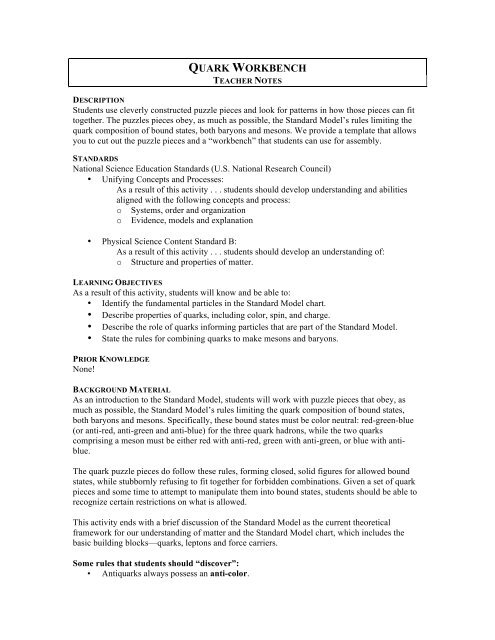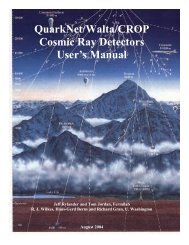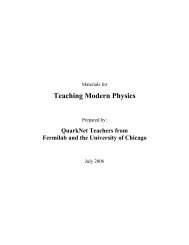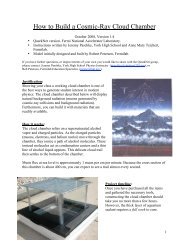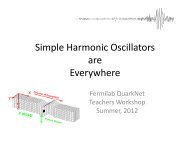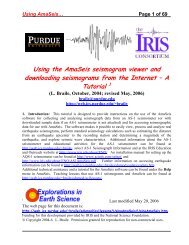QUARK WORKBENCH - QuarkNet
QUARK WORKBENCH - QuarkNet
QUARK WORKBENCH - QuarkNet
Create successful ePaper yourself
Turn your PDF publications into a flip-book with our unique Google optimized e-Paper software.
<strong>QUARK</strong> <strong>WORKBENCH</strong><br />
TEACHER NOTES<br />
DESCRIPTION<br />
Students use cleverly constructed puzzle pieces and look for patterns in how those pieces can fit<br />
together. The puzzles pieces obey, as much as possible, the Standard Model’s rules limiting the<br />
quark composition of bound states, both baryons and mesons. We provide a template that allows<br />
you to cut out the puzzle pieces and a “workbench” that students can use for assembly.<br />
STANDARDS<br />
National Science Education Standards (U.S. National Research Council)<br />
• Unifying Concepts and Processes:<br />
As a result of this activity . . . students should develop understanding and abilities<br />
aligned with the following concepts and process:<br />
o Systems, order and organization<br />
o Evidence, models and explanation<br />
• Physical Science Content Standard B:<br />
As a result of this activity . . . students should develop an understanding of:<br />
o Structure and properties of matter.<br />
LEARNING OBJECTIVES<br />
As a result of this activity, students will know and be able to:<br />
• Identify the fundamental particles in the Standard Model chart.<br />
• Describe properties of quarks, including color, spin, and charge.<br />
• Describe the role of quarks informing particles that are part of the Standard Model.<br />
• State the rules for combining quarks to make mesons and baryons.<br />
PRIOR KNOWLEDGE<br />
None!<br />
BACKGROUND MATERIAL<br />
As an introduction to the Standard Model, students will work with puzzle pieces that obey, as<br />
much as possible, the Standard Model’s rules limiting the quark composition of bound states,<br />
both baryons and mesons. Specifically, these bound states must be color neutral: red-green-blue<br />
(or anti-red, anti-green and anti-blue) for the three quark hadrons, while the two quarks<br />
comprising a meson must be either red with anti-red, green with anti-green, or blue with antiblue.<br />
The quark puzzle pieces do follow these rules, forming closed, solid figures for allowed bound<br />
states, while stubbornly refusing to fit together for forbidden combinations. Given a set of quark<br />
pieces and some time to attempt to manipulate them into bound states, students should be able to<br />
recognize certain restrictions on what is allowed.<br />
This activity ends with a brief discussion of the Standard Model as the current theoretical<br />
framework for our understanding of matter and the Standard Model chart, which includes the<br />
basic building blocks—quarks, leptons and force carriers.<br />
Some rules that students should “discover”:<br />
• Antiquarks always possess an anti-color.
• All baryons consist of three quarks or of three antiquarks.<br />
• The three quarks making up each baryon must consist of the three primary colors: red,<br />
green and blue, or the three anti-colors: anti-blue (yellow), anti-green (magenta) or<br />
anti-red (cyan).<br />
• All mesons consist of two quarks: one quark and an antiquark.<br />
• The two quarks in any meson must possess a color and its anti-color.<br />
• All hadrons posses a total charge of -2, -1, 0, +1, or +2.<br />
• All mesons posses a total charge of -1, 0, or +1.<br />
Some limitations of the quark puzzle pieces:<br />
• Of course, quarks are not shaped like the puzzle pieces; nor do they possess true colors.<br />
• Neither leptons (including electrons) nor WEAK interactions can be described by these<br />
pieces.<br />
• The gluons which bind the quarks into the nucleus are also not represented.<br />
• The quark pieces cannot describe any of numerous known particles found in<br />
superpositions, such as the π 0 , a superposition of uu and dd.<br />
IMPLEMENTATION<br />
Project the Standard Model Chart of Elementary Particles (found at http://tinyurl.com/yjwykef)<br />
and discuss the generations, difference between leptons, quarks and force carriers. (You can find<br />
some material to prompt this discussion at http://tinyurl.com/yfcbocr.) Point out the large<br />
difference in masses between the quarks (this will foreshadow the next activity in this packet) and<br />
the fact that the only massless particle on the chart is the photon. Discuss the fact that the<br />
particles here represent the “building blocks” of nature—everything else in the universe is<br />
comprised of these particles. Everything. Point out that that the familiar proton is comprised of<br />
three valence quarks (up-up-down) and many other virtual quark pairs and gluons.<br />
Introduce the Quark Workbench activity as a way to determine the combination rules for the<br />
quarks as they form composite particles.<br />
A few important points:<br />
1. The Standard Model chart illustrated the fundamental building blocks of matter and the<br />
force carriers that govern their interactions with one another.<br />
2. It is surprising that only the up and down quarks and the electron make up all the<br />
ordinary matter around us.<br />
3. Once we understand the rules for combining these fundamental particles, we can make<br />
hundreds of other particles.<br />
4. The Standard Model, usually illustrated by the Standard Model chart is, of course, much<br />
more than the chart and is the current theoretical framework for our understanding of<br />
matter.<br />
We recommend printing the puzzle pieces (the following pages) on card stock and laminating<br />
game boards.
ASSESSMENT<br />
During the activity, you might ask:<br />
• What color are all of the bound states that you have discovered?<br />
• What is the net charge of the bound states that you have discovered?<br />
• How many bound quarks are required to make a meson? A baryon?<br />
When the students have finished the activity, project the Elementary Particles chart again.<br />
Discuss the fact that they have investigated a small part of the Standard Model—one that<br />
describes formation of baryons and mesons. There is more to learn about the Standard Model—<br />
both for the students and for physicists.<br />
• What rules did you discover that determine the composition of baryons? Mesons?<br />
• What role did quarks play in forming the mesons and baryons?<br />
• In addition to quarks, what other particles are "fundamental"?<br />
• What do physicists call the current theoretical framework for our understanding of<br />
matter?<br />
ADDITIONAL INFORMATION<br />
The proton and neutron are baryons. As an extension to the activity, ask the students to determine<br />
the possible quark combinations to construct these "particles" that they are aware of. Remind the<br />
students that protons and neutrons are matter (they could also make antiprotons and antineutrons),<br />
and discuss the results.<br />
1. Proton: uud<br />
2. Neutron: udd<br />
3. Antiproton: (uud)<br />
4. Construct the pion family: π + (ud) ; π − (ud); and π 0 (uu) or (dd).<br />
You may wish to discuss that each π 0 is known to be a superposition of those two states.<br />
Variations:<br />
• Print and cut out an excess of up and down quarks, in order to suggest that all quark<br />
types are not equally prevalent; in fact, the other quark types are quite rare in the universe<br />
we are used to.<br />
• Use the quarks in a game similar to gin rummy. Each “player” starts with ten quark<br />
pieces; the object of the game is for a player to be the first to use up all of their ten pieces<br />
by building several composite particles (baryons or mesons). Players take turns, each<br />
trying to develop ONE particle—only one per turn is allowed. If a particle is constructed,
it and its quark constituents leave the player’s hand and remain on the table for the<br />
remainder of the game. If unwilling or unable to form a particle, the player must select a<br />
“random” quark from a stockpile and wait a turn to construct.<br />
Eric Gettrust is a physics teacher in Madison, Wisconsin. He created this puzzle activity for his<br />
students in the summer of 2008 after a summer appointment as a <strong>QuarkNet</strong> Lead Teacher in the<br />
physics department at the University of Wisconsin. He published the idea in The Physics Teacher<br />
during the spring of 2010.
MESON<br />
<strong>WORKBENCH</strong><br />
BUILD MESONS HERE<br />
• Quark pieces must fit together like puzzle pieces: no overlapping.<br />
• There must be no empty spots on the inside of the particle formed:<br />
ALLOWED ALLOWED FORBIDDEN FORBIDDEN<br />
BARYON<br />
<strong>WORKBENCH</strong><br />
BUILD BARYONS HERE
!<br />
!<br />
!<br />
!<br />
!<br />
u<br />
+ 2<br />
3<br />
blue<br />
!<br />
!<br />
!<br />
!<br />
u<br />
" 2<br />
3<br />
blue<br />
" 2<br />
3<br />
!<br />
u<br />
red<br />
!<br />
!<br />
!<br />
!<br />
!<br />
!<br />
!<br />
u<br />
+ 2<br />
3<br />
red<br />
!<br />
d<br />
" 1<br />
3<br />
blue<br />
!<br />
!<br />
!<br />
d<br />
+ 1<br />
3<br />
blue<br />
d<br />
+ 1<br />
3<br />
red<br />
!<br />
!<br />
!<br />
!<br />
!<br />
!<br />
u<br />
+ 2<br />
3<br />
green<br />
!<br />
d<br />
" 1<br />
3<br />
red<br />
!<br />
!<br />
u<br />
" 2<br />
3<br />
green<br />
TEACHER: Cut out each Quark puzzle piece beforehand. Each will be one color<br />
(or anti-color). Discard the white dots. Card stock ! will make better pieces than plain<br />
white paper.<br />
Recommendation: Print out many extra copies of this page, to help represent that up<br />
and down quarks comprise the particles common to our experience.<br />
<strong>QUARK</strong> PIECES pg. 1 of 3<br />
!<br />
!<br />
d<br />
+ 1<br />
3<br />
green<br />
!<br />
!<br />
!<br />
d<br />
" 1<br />
3<br />
green
'<br />
+ !<br />
"<br />
#$%&<br />
'(<br />
!<br />
"<br />
#$%&<br />
.(<br />
!<br />
"<br />
*&-<br />
.<br />
+ !<br />
"<br />
'(<br />
!<br />
"<br />
*&-<br />
*&-<br />
'<br />
+ !<br />
"<br />
*&-<br />
#(<br />
+ !<br />
"<br />
*&-<br />
)*&&+<br />
!"#$%"&'(($)*(+)*(,-./(0)-12(3)445,(36,.,(7,8+1,/-9:;((<br />
"-./(.+5+1?;(( @6A.-1:(*/,(
!<br />
!<br />
blue !<br />
!<br />
!<br />
t<br />
+ 2<br />
3<br />
!<br />
!<br />
!<br />
t<br />
" 2<br />
3<br />
blue !<br />
!<br />
t<br />
" 2<br />
3<br />
green !<br />
!<br />
!<br />
!<br />
blue !<br />
+ 2<br />
3<br />
b<br />
" 1<br />
3<br />
t!<br />
!<br />
green !<br />
!<br />
b<br />
+ 1<br />
3<br />
blue !<br />
!<br />
b<br />
+ 1<br />
3<br />
green !<br />
!<br />
!<br />
!<br />
s<br />
" 1<br />
3<br />
blue !<br />
b!<br />
!<br />
" 1<br />
3<br />
green !<br />
!<br />
s<br />
+ 1<br />
3<br />
green<br />
!<br />
TEACHER: Cut out each Quark puzzle piece beforehand.<br />
!<br />
Each will be one color (or anti-color). Discard the white dots.<br />
<strong>QUARK</strong> PIECES<br />
pg. 3 of 3<br />
!<br />
blue<br />
!<br />
s<br />
+ 1<br />
3<br />
!<br />
s<br />
" 1<br />
3<br />
green


